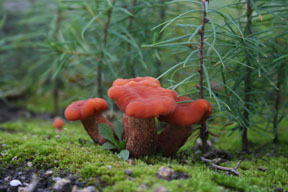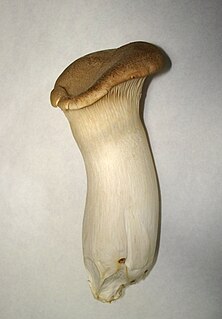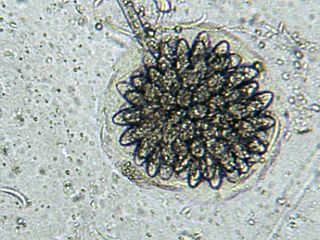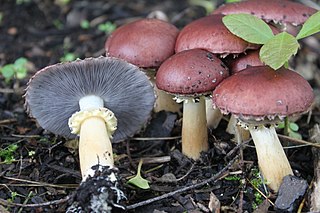 W
WCarnivorous fungi or predaceous fungi are fungi that derive some or most of their nutrients from trapping and eating microscopic or other minute animals. More than 200 species have been described, belonging to the phyla Ascomycota, Mucoromycotina, and Basidiomycota. They usually live in soil and many species trap or stun nematodes, while others attack amoebae or collembola.
 W
WCoprinus comatus, the shaggy ink cap, lawyer's wig, or shaggy mane, is a common fungus often seen growing on lawns, along gravel roads and waste areas. The young fruit bodies first appear as white cylinders emerging from the ground, then the bell-shaped caps open out. The caps are white, and covered with scales—this is the origin of the common names of the fungus. The gills beneath the cap are white, then pink, then turn black and secrete a black liquid filled with spores. This mushroom is unusual because it will turn black and dissolve itself in a matter of hours after being picked or depositing spores.
 W
WLaccaria bicolor is a small tan-colored mushroom with lilac gills. It is edible but not choice, and grows in mixed birch and pine woods. It is found in the temperate zones of the globe, in late summer and autumn. L. bicolor is an ectomycorrhizal fungus used as a soil inoculant in agriculture and horticulture.
 W
WNematophagous fungi are carnivorous fungi specialized in trapping and digesting nematodes. Around 160 species are known. There exist both species that live inside the nematodes from the beginning and others that catch them, mostly with glue traps or in rings, some of which constrict on contact. Some species possess both types of traps. Another technique is to stun the nematodes using toxins, which is a method employed by Coprinus comatus, Stropharia rugosoannulata, and the family Pleurotaceae. The habit of feeding on nematodes has arisen many times among fungi, as is demonstrated by the fact that nematophagous species are found in all major fungal groups. Nematophagous fungi can be useful in controlling those nematodes that eat crops. Purpureocillium, for example, can be used as a bio-nematicide.
 W
WPaecilomyces is a genus of fungi. A number of species in this genus are plant pathogens.
 W
WPleurotus is a genus of gilled mushrooms which includes one of the most widely eaten mushrooms, P. ostreatus. Species of Pleurotus may be called oyster, abalone, or tree mushrooms, and are some of the most commonly cultivated edible mushrooms in the world. Pleurotus fungi have been used in mycoremediation of pollutants such as petroleum and polycyclic aromatic hydrocarbons. Oyster mushrooms contain lovastatin, a form of cholesterol lowering statin.
 W
WPleurotus citrinopileatus, the golden oyster mushroom, is an edible gilled fungus. Native to eastern Russia, northern China, and Japan, the golden oyster mushroom is very closely related to P. cornucopiae of Europe, with some authors considering them to be at the rank of subspecies. In far eastern Russia, P. citrinopileatus, they are called iI'mak, is one of the most popular wild edible mushrooms.
 W
WPleurotus dryinus is a species of fungus in the family Pleurotaceae. It grows on dead wood and is also a weak pathogen; infecting especially broad-leaved trees.
 W
WPleurotus eryngii is an edible mushroom native to Mediterranean regions of Europe, the Middle East, and North Africa, but also grown in many parts of Asia.
 W
WPleurotus nebrodensis, commonly known as Funciu di basilicu is a fungus that was declared by the IUCN as critically endangered in 2006. This fungus only grows on limestone in northern Sicily in association with Cachrys ferulacea. The characteristics of the mushroom are its creamy white to yellow colour, its diameter of between 5 and 20 centimeters, its extremely angled gills, and the breaking apart of the cap surface at maturity.
 W
WPleurotus ostreatus, the oyster mushroom or oyster fungus, is a common edible mushroom. It was first cultivated in Germany as a subsistence measure during World War I and is now grown commercially around the world for food. It is related to the similarly cultivated king oyster mushroom. Oyster mushrooms can also be used industrially for mycoremediation purposes.
 W
WPleurotus populinus, the aspen oyster mushroom, is a gilled fungus native to North America. It is found on dead wood of aspen and cottonwood trees. Although morphologically similar to Pleurotus ostreatus and Pleurotus pulmonarius, it has been shown to be a distinct species incapable of cross-breeding. P. populinus is reported to be edible. Unlike P. ostreatus, which fruits in the autumn and winter, P. populinus fruits in late spring and summer.
 W
WPleurotus pulmonarius, commonly known as the Indian Oyster, Italian Oyster, Phoenix Mushroom, or the Lung Oyster, is a mushroom very similar to Pleurotus ostreatus, the pearl oyster, but with a few noticeable differences. The caps of pulmonarius are much paler and smaller than ostreatus and develops more of a stem. P. pulmonarius also prefers warmer weather than ostreatus and will appear later in the summer. Otherwise, the taste and cultivation of the two species is generally described as largely the same. In North America, P. pulmonarius also closely resembles Pleurotus populinus, which is restricted to growing on aspen and cottonwood.
 W
WPurpureocillium is a fungal genus in the Ophiocordycipitaceae family. The genus now contains at least 5 species with the type species Purpureocillium lilacinum, a common saprobic, filamentous fungus. It has been isolated from a wide range of habitats, including cultivated and uncultivated soils, forests, grassland, deserts, estuarine sediments and sewage sludge, and insects. It has also been found in nematode eggs, and occasionally from females of root-knot and cyst nematodes. In addition, it has frequently been detected in the rhizosphere of many crops. The species can grow at a wide range of temperatures – from 8 to 38 °C for a few isolates, with optimal growth in the range 26 to 30 °C. It also has a wide pH tolerance and can grow on a variety of substrates. P. lilacinum has shown promising results for use as a biocontrol agent to control the growth of destructive root-knot nematodes.
 W
WRhopalomyces elegans is a common species of zygomycete fungus, and the type species of the genus Rhopalomyces. Widely distributed, it is found in soil, rotting plant material, and animal dung. It is a facultative parasite of nematode eggs.
 W
WStropharia rugosoannulata, commonly known as the wine cap stropharia, "garden giant", burgundy mushroom or king stropharia, is an agaric of the family Strophariaceae found in Europe and North America, and introduced to Australia and New Zealand. The mushroom was reported in April 2018 in Colombia, in the city of Bogota. Unlike many other members of the genus Stropharia, it is regarded as a choice edible and is commercially cultivated.